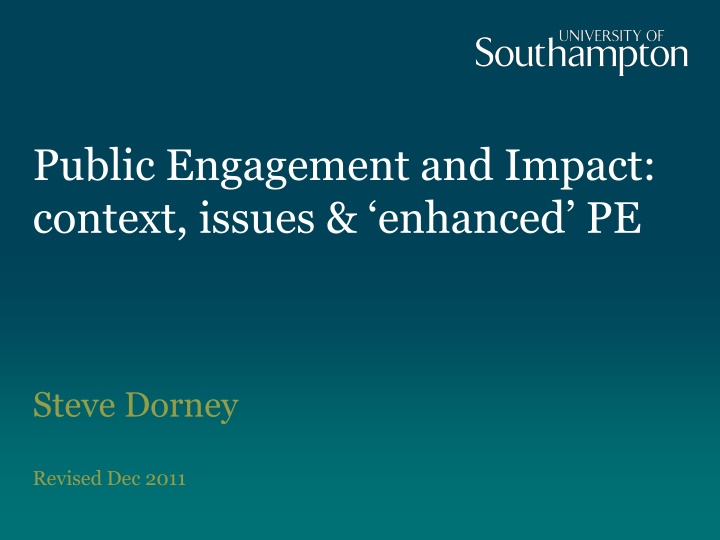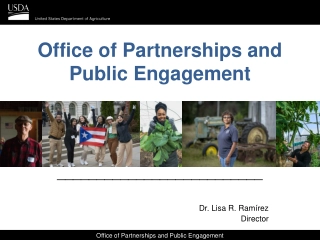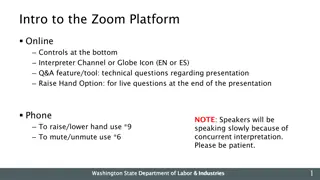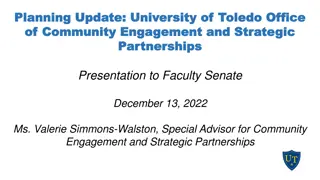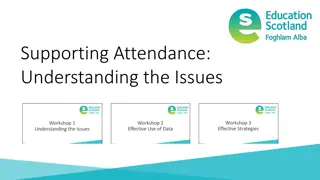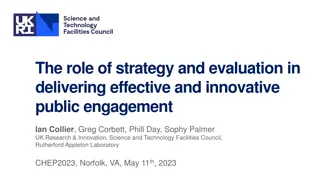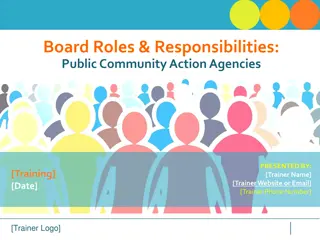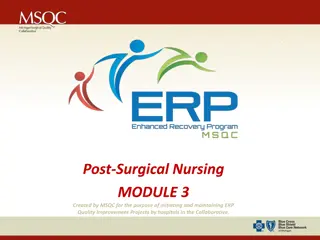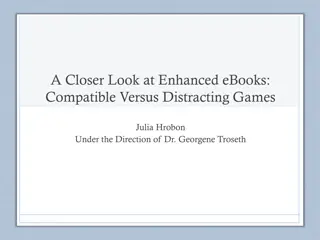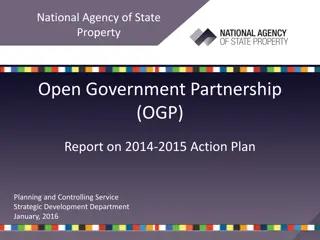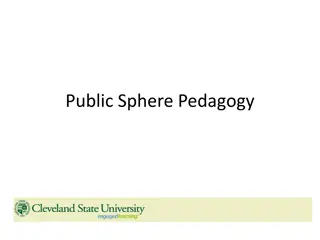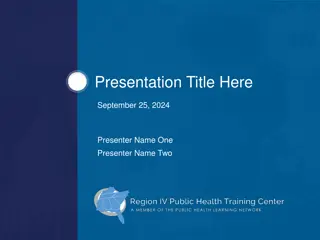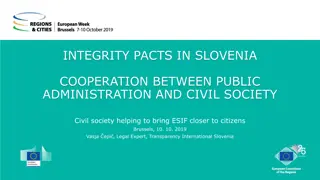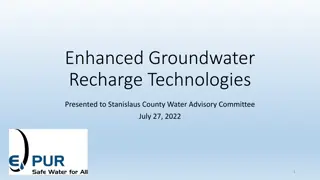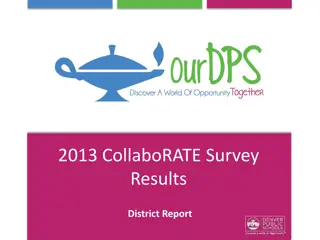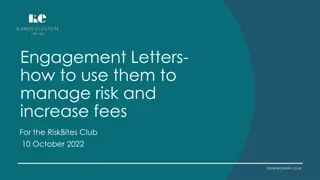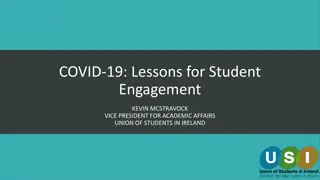Public Engagement and Impact: Issues & Enhanced PE Overview
These slides explore the connection between public engagement and research impact, including definitions, activities, REF criteria, and assessment methods. Learn about the significance of engaging with the public in research processes.
Download Presentation

Please find below an Image/Link to download the presentation.
The content on the website is provided AS IS for your information and personal use only. It may not be sold, licensed, or shared on other websites without obtaining consent from the author.If you encounter any issues during the download, it is possible that the publisher has removed the file from their server.
You are allowed to download the files provided on this website for personal or commercial use, subject to the condition that they are used lawfully. All files are the property of their respective owners.
The content on the website is provided AS IS for your information and personal use only. It may not be sold, licensed, or shared on other websites without obtaining consent from the author.
E N D
Presentation Transcript
Public Engagement and Impact: context, issues & enhanced PE Steve Dorney Revised Dec 2011
Note These slides outline the background connections between public engagement and research impact (e.g. as understood in the context of REF Impact Case Studies, Pathways to Impact and the RCUK Concordat for Engaging the Public with Research) Further information and links to documents can be found via the National Co-ordinating Centre for Public Engagement (NCCPE) website at www.publicengagement.ac.uk 2
What is public engagement? Public engagement describes the myriad of ways in which the activity and benefits of higher education and research can be shared with the public. Engagement is by definition a two- way process, involving interaction and listening, with the goal of generating mutual benefit Defined after wide consultation by National Co-ordinating Centre for Public Engagement (NCCPE) www.publicengagement.ac.uk NCCPE has a leading role re the REF panel criteria for PE Note that Southampton is a signatory to the NCCPE Manifesto 3
What is PE? 2 Purpose Exemplar activities INFORMING: Inspiring, informing and educating presentations and lectures festival appearances media work exhibitions writing for non-specialists, whether online or in journalism or books. Here the goal is to communicate the activity and outputs of research, while encouraging feedback, comments and questions public meetings and discussion events panels and user groups online consultation deliberation and 'upstream' engagement CONSULTING: Actively listening to the public s views, insights and concerns Here the goal is to feed the public s views and insights into the research process itself collaborative research projects citizen science where the public are actively involved in the collection and analysis of data helpdesks or the like, to make it easy for people outside the university to draw on university expertise COLLABORATING: Working in partnership with the public to solve problems together, drawing on each other s expertise Here the goal is to involve the public as participants and collaborators in the research process Slide content by Paul Manners, Director, NCCPE 4
How will the REF define PE? 4 pilot impact panels worked on assessment criteria for PE NCCPE steer: we commend Panel B s guidance to the other panels (REF consultation response, Oct 2011) 74. Public engagement is an activity that may enhance or extend the impact of research. Sub- panels will welcome case studies that include impact achieved in this way, either as the main impact described or as one facet of a broader range of impacts. 5
How will the REF assess PE? Pilot Panel B version again 75. Public engagement is a very broad area, not all of which is underpinned by research. Case studies which include impacts that derive from public engagement must: a. Be directly connected to specific research or a body of research carried out in the unit, and explain clearly which particular aspects of the research underpinned the engagement activity and contributed to the impact claimed. 6
How will the REF assess PE? [reach] b. Include evidence of the reach of the impact. This should extend beyond simply providing the numbers of people engaged and may also, for example, include: information about the types of audience whether there was secondary reach, for example from follow-up or media coverage other quantitative indicators such as evidence of sales, downloads of linked resources, and/or access to web content. 7
How will the REF assess PE? [significance] c. Include evidence of the significance of the impact. This should include a description of the social, cultural or other significance of the research insights with which the public have engaged. Examples of the evidence that might be provided for this include: evaluation data user feedback or testimony critical external reviews of the engagement activity evidence of third party involvement, for example how collaborators have modified their practices, contributions (cash or in-kind) by third parties to enhance services or support for the public, or evidence of funds from third parties to enhance or extend the engagement activity evidence of sustainability, through, for example, a sustained or ongoing engagement with a group, a significant increase in participation in events or programmes, continuing sales, downloads, or use of resources. 8
REF Impact reminder RCUK scheme 9
Examples of PE that generate impacts 1 In the areas of civil society, policy making and public services: Dialogue, debate and engagement with the public about the application of new ideas and practices to policy and infrastructure provision (e.g. related to health, environmental behaviours, service provision, social equity or social cohesion) [NCCPE Discussion Paper: Assessing impacts arising from public engagement with research] 10
Examples of PE that generate impacts 2 In the area of cultural and economic impact and quality of life: Enriching public discourse and quality of life by introducing new research-led perspectives and insights into the public domain, through workshops, events, performance, exhibitions or media work (print and broadcast) Stimulating public interest in research and direct engagement in informing research [NCCPE Discussion Paper: Assessing impacts arising from public engagement with research] 11
Summary : PE to support 4* Impact? A clear link between the research and the engagement activity. Evidence of dissemination as well as a clear explanation of the significance or benefits to the audiences. Think about publics by geography or interest. Expectation that PE will go beyond business as usual engagement, e.g. a innovative programme of activity, sustainable, clearly identified benefits to others. Maximising the value of a discipline s impact signature 12
Issues to consider Enhanced engagement vs. business as usual how is research impact of type X enhanced by PE type Y? Can you demonstrate 2-way engagement? What does dialogue look like in your discipline? NCCPE influence/likely panel membership HEFCE to include research users on panels who? Sustainability valued over serendipity Impact = reach AND significance Impact activity shouldn t be the only sanctioned form of PE 13
Practical routes to enhanced PE part 1 Join the UoS PE Network (J.M.James@soton.ac.uk) Series of working lunches with mini-seminars Resource for PE activists Adapt case studies of best practice from NCCPE pages at www.publicengagement.ac.uk 14
Practical routes to enhanced PE part 2 PGR training via GradBook (Steve Dorney/Kirsten Wythe) Learn with US content opportunities (Richard Kennett) Impact roadshow (Steve Dorney/Helen Czerski/Tony Curran) Expansion of LLL programme (Helen Spurling) Student Centredness Fund (Debra Humphris) Web 2.0/social networking (Jon Copley) Expand role at cyclical UoS events (e.g. NSEW) 15
Practical routes to enhanced PE part 3 Apply for RCUK awards specific to PE (e.g. Wellcome Arts Award) Consider working with citizen researchers Provide CPD for teachers and for non-Uni researchers Build partnerships with museums/science centres (e.g. Intech) Engage more policymakers with research briefings Engage with more NGOs/Third Sector (e.g. SoNG outreach event) 16
Environment routes to enhanced PE 1 Concordat for Engaging the Public with Research Joint statement from Research Councils UK (RCUK), the Funding Councils, academies and research charities setting out expectations and responsibilities of research funders with respect to public engagement. Do you have an engagement strategy? Are staff resources committed to PE work at UoA level? Are researchers recognised for PE work (e.g. workload?) Are there opportunities for PE training/development? 17
Environment routes to enhanced PE 2 VITAE Researcher Development Framework Domain D: Engagement, Influence and Impact Do you map researcher training onto the RDF? Do you connect impact with career development through the RDF stages? 18
Beyond REF2014 Pathways to Impact Plan ahead for next REF Design or borrow mechanism for tracking impact and PE RCUK Catalysts bid (17 Nov 11) Connecting best practice in UoS Re-thinking community interaction Reward and recognition programme 19
